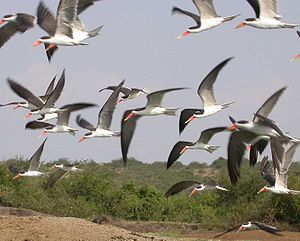Braunmantel scissors beak
| Braunmantel scissors beak | ||||||||||||
|---|---|---|---|---|---|---|---|---|---|---|---|---|

Brown-mantled scissors beak ( Rynchops flavirostris ) |
||||||||||||
| Systematics | ||||||||||||
|
||||||||||||
| Scientific name | ||||||||||||
| Rynchops flavirostris | ||||||||||||
| Vieillot , 1816 |
The brown-coat scissors beak ( Rynchops flavirostris ), also known as the African scissors beak, is an African bird of the order of the plover-like (Charadriiformes).
features
The 40 cm long brown-coat scissor beak is a seagull-like bird with a large head, long wings, short tail, red legs and a long, red beak with a pale tip. The lower bill is significantly longer than the upper bill. The plumage is dark brown or black on top. The forehead, underside and the rear edges of the wings are white.
The plumage of the young bird is paler, the beak shorter and blackish, the legs yellowish.
Occurrence
The brood distribution of the brown-mantled scissors-beak extends over large parts of sub-Saharan Africa , where it lives on coasts, lakes and rivers. The southern limit of distribution runs roughly along the Orange River .
behavior
The brown-coat scissors beak spends most of the day sleeping, cleaning and bathing and essentially only forages between sunset and sunrise in order to avoid encounters with seagulls that can steal their prey. The bird plows through the water surface with its lower bill, flying close to the water. If it comes into contact with a fish, it snaps shut with its upper beak.
Reproduction
The brown mantle scissors bills breed in colonies with up to 20 breeding pairs. The clutch of two to four eggs is incubated for about three weeks. In scorching heat, the parent birds cool the eggs by settling on the clutch with moistened belly plumage. The young birds, which leave the nest after one or two days, are looked after by their parents for a few more weeks.
Breeding predators , such as skuas , are chased away by attacking them aggressively in a dive with beaked blows. Another defense strategy is to lure enemies away from the brood by feigning injury. (See also: Enticing .)
Hazardous situation
The brown-mantled scissors beak is listed by the International Union for Conservation of Nature ( IUCN) in the Red List of Threatened Species as Near Threatened because of its only slightly reduced population . In the event of a further acceptance, a higher risk category would have to be selected. It is considered extinct in South Africa.
literature
- Colin Harrison & Alan Greensmith: Birds. Dorling Kindersly Limited, London 1993,2000, ISBN 3-8310-0785-3
- Stevenson and Fanshawe: Princeton Field Guides - Birds of East Africa , Princeton and Oxford, 2002 ISBN 0-691-12665-8
Web links
- Videos, photos and sound recordings of Rynchops flavirostris in the Internet Bird Collection
Individual evidence
- ↑ Gerald S. Tuck, Hermann Heinzel: Die Meeresvögel der Welt , Verlag Paul Parey, Hamburg / Berlin 1980, ISBN 3-490-07818-7 , p. 165
- ↑ Rynchops flavirostris in the endangered Red List species the IUCN 2009. Posted by: BirdLife International, 2008. Accessed on March 11 of 2010.